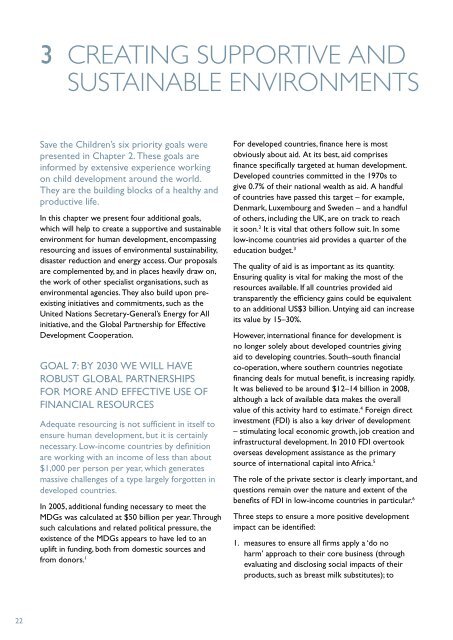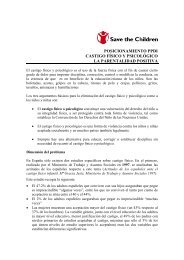ENDING poverty - Save the Children
ENDING poverty - Save the Children
ENDING poverty - Save the Children
You also want an ePaper? Increase the reach of your titles
YUMPU automatically turns print PDFs into web optimized ePapers that Google loves.
3 CREATING SUPPORTIVE AND<br />
SUSTAINABLE ENVIRONMENTS<br />
<strong>Save</strong> <strong>the</strong> <strong>Children</strong>’s six priority goals were<br />
presented in Chapter 2. These goals are<br />
informed by extensive experience working<br />
on child development around <strong>the</strong> world.<br />
They are <strong>the</strong> building blocks of a healthy and<br />
productive life.<br />
In this chapter we present four additional goals,<br />
which will help to create a supportive and sustainable<br />
environment for human development, encompassing<br />
resourcing and issues of environmental sustainability,<br />
disaster reduction and energy access. Our proposals<br />
are complemented by, and in places heavily draw on,<br />
<strong>the</strong> work of o<strong>the</strong>r specialist organisations, such as<br />
environmental agencies. They also build upon preexisting<br />
initiatives and commitments, such as <strong>the</strong><br />
United Nations Secretary-General’s Energy for All<br />
initiative, and <strong>the</strong> Global Partnership for Effective<br />
Development Cooperation.<br />
GOAL 7: BY 2030 WE WILL HAVE<br />
ROBUST GLOBAL PARTNERSHIPS<br />
FOR MORE AND EFFECTIVE USE OF<br />
FINANCIAL RESOURCES<br />
Adequate resourcing is not sufficient in itself to<br />
ensure human development, but it is certainly<br />
necessary. Low-income countries by definition<br />
are working with an income of less than about<br />
$1,000 per person per year, which generates<br />
massive challenges of a type largely forgotten in<br />
developed countries.<br />
In 2005, additional funding necessary to meet <strong>the</strong><br />
MDGs was calculated at $50 billion per year. Through<br />
such calculations and related political pressure, <strong>the</strong><br />
existence of <strong>the</strong> MDGs appears to have led to an<br />
uplift in funding, both from domestic sources and<br />
from donors. 1<br />
For developed countries, finance here is most<br />
obviously about aid. At its best, aid comprises<br />
finance specifically targeted at human development.<br />
Developed countries committed in <strong>the</strong> 1970s to<br />
give 0.7% of <strong>the</strong>ir national wealth as aid. A handful<br />
of countries have passed this target – for example,<br />
Denmark, Luxembourg and Sweden – and a handful<br />
of o<strong>the</strong>rs, including <strong>the</strong> UK, are on track to reach<br />
it soon. 2 It is vital that o<strong>the</strong>rs follow suit. In some<br />
low-income countries aid provides a quarter of <strong>the</strong><br />
education budget. 3<br />
The quality of aid is as important as its quantity.<br />
Ensuring quality is vital for making <strong>the</strong> most of <strong>the</strong><br />
resources available. If all countries provided aid<br />
transparently <strong>the</strong> efficiency gains could be equivalent<br />
to an additional US$3 billion. Untying aid can increase<br />
its value by 15–30%.<br />
However, international finance for development is<br />
no longer solely about developed countries giving<br />
aid to developing countries. South–south financial<br />
co-operation, where sou<strong>the</strong>rn countries negotiate<br />
financing deals for mutual benefit, is increasing rapidly.<br />
It was believed to be around $12–14 billion in 2008,<br />
although a lack of available data makes <strong>the</strong> overall<br />
value of this activity hard to estimate. 4 Foreign direct<br />
investment (FDI) is also a key driver of development<br />
– stimulating local economic growth, job creation and<br />
infrastructural development. In 2010 FDI overtook<br />
overseas development assistance as <strong>the</strong> primary<br />
source of international capital into Africa. 5<br />
The role of <strong>the</strong> private sector is clearly important, and<br />
questions remain over <strong>the</strong> nature and extent of <strong>the</strong><br />
benefits of FDI in low-income countries in particular. 6<br />
Three steps to ensure a more positive development<br />
impact can be identified:<br />
1. measures to ensure all firms apply a ‘do no<br />
harm’ approach to <strong>the</strong>ir core business (through<br />
evaluating and disclosing social impacts of <strong>the</strong>ir<br />
products, such as breast milk substitutes); to<br />
22
















